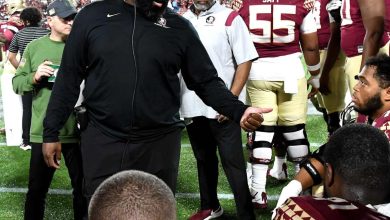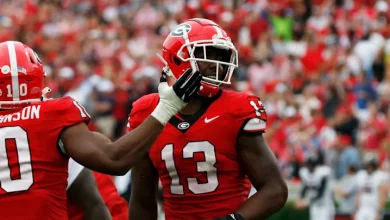How the Ohio State football program is affected by Chip Kelly’s decision to join the NFL

The Ohio State football program, one of the most storied and successful in college football, has long been recognized for its powerhouse offenses, elite recruiting classes, and strong leadership. As a program that has seen consistent success over the years, Ohio State’s ability to adapt and evolve in a competitive landscape has been crucial to its dominance. However, one of the most impactful developments in recent months has been the departure of Chip Kelly, the Buckeyes’ former offensive coordinator, who made the decision to return to the NFL.
Kelly’s time at Ohio State was brief but transformative. As an offensive mind known for his innovative schemes and high-tempo, spread offense, Kelly was expected to bring new energy and strategic depth to the Buckeyes’ offense. His decision to leave has raised numerous questions and concerns about the future of Ohio State football, especially given the importance of offensive schemes in the modern game. In this piece, we will explore the ways in which Ohio State football is affected by Kelly’s decision, analyzing both the short- and long-term consequences of his departure.
Chip Kelly’s Impact on Ohio State Football
When Chip Kelly was hired by Ohio State, the excitement was palpable. Kelly had already made a name for himself as one of the most innovative offensive minds in football, most notably during his time at Oregon. His fast-paced, no-huddle offense was revolutionary at the collegiate level and had been extremely successful. As a result, when Kelly arrived at Ohio State, there were high expectations for him to bring a similar level of innovation to the Buckeyes’ offense.
Ohio State’s offensive approach under Kelly initially promised to deliver a more modern, dynamic attack, which would make full use of the talent the program had assembled. Kelly’s use of tempo, spread formations, and innovative concepts like the zone read and RPO (run-pass option) fit well with Ohio State’s existing personnel, particularly their deep quarterback and wide receiver groups. In his short time with the Buckeyes, Kelly helped revitalize the offense, making it one of the most potent units in the country.
His work with quarterbacks, in particular, was significant. Kelly has always been known for getting the best out of his quarterbacks, and under his tutelage, Ohio State quarterbacks showed improvement in their decision-making, pocket awareness, and overall execution. The system that Kelly introduced allowed Ohio State’s quarterbacks to thrive in a more up-tempo offense, while also opening up the field for playmakers at the skill positions.
Immediate Consequences of Kelly’s Departure
Kelly’s sudden departure to the NFL has created a ripple effect that has been felt throughout the Ohio State program. The immediate consequences of this decision are significant, and they impact various aspects of the team, from recruiting to offensive identity.
1. Offensive Scheme and Philosophy
Perhaps the most immediate and obvious consequence of Kelly’s departure is the impact it has on Ohio State’s offensive scheme. Under Kelly, the Buckeyes had implemented a fast-paced, high-tempo system that required quick decision-making and adaptability from the offense. With Kelly’s departure, Ohio State will need to find a new offensive coordinator who can continue to run a system that is both effective and complementary to the team’s existing strengths.
While Ohio State has a talented coaching staff capable of adjusting to these changes, the loss of Kelly’s innovation is a blow. The Buckeyes’ offensive playbook will have to evolve, which could result in a period of transition as the new offensive coordinator integrates his own philosophy and approach into the program. Ohio State’s success under Kelly was built on tempo, movement, and creating mismatches in space. Replacing that with a new system will require time, practice, and a recalibration of how the team approaches offensive football.
2. Recruiting Impact
Chip Kelly’s arrival at Ohio State also brought a sense of excitement to the recruiting process. Known for his ability to attract top-tier talent, Kelly’s offensive system was a major draw for many high school recruits, particularly those on the offensive side of the ball. His reputation as an offensive genius, combined with his history of developing quarterbacks and skill players, made Ohio State a more attractive destination for some of the best recruits in the country.
Now, with Kelly’s sudden departure, the Buckeyes could face challenges in keeping some of these recruits who were specifically drawn to the program because of Kelly’s presence. It is not uncommon for recruits to make their decisions based on the coaches who are leading the program, and when those coaches leave, there can be significant ramifications in terms of commitment. Ohio State will have to quickly move to stabilize their recruiting efforts, ensuring that they don’t lose key prospects who may be on the fence about the program’s direction without Kelly at the helm.
While Ohio State is still a premier program with a rich history, the loss of Kelly could have a destabilizing effect on recruiting if the team doesn’t quickly adapt and find a new offensive coordinator who can instill confidence in recruits and their families. The program’s ability to attract elite quarterbacks, wide receivers, and offensive linemen will largely depend on the offensive vision of Kelly’s replacement.
3. Quarterback Development and the Next Offensive Leader
One of the most important positions on any football team is the quarterback, and under Kelly, Ohio State’s quarterbacks were set to continue thriving in his fast-paced, read-heavy system. Now, with Kelly out of the picture, the future of Ohio State’s quarterback development is in flux. The Buckeyes have several talented quarterbacks on the roster, but the question remains: How will they develop without Kelly’s offensive expertise?
Kelly was known for his ability to develop quarterbacks who could excel in high-tempo offenses, and it is no secret that Ohio State’s quarterbacks were excited about the opportunity to work with him. Whether it’s Kyle McCord, a talented freshman, or a veteran quarterback, whoever takes the reins in 2025 will need to adjust to a new coaching style, potentially leading to a dip in development as they adjust to a different offensive philosophy.
4. Continuity and Leadership Within the Team
Kelly’s departure also has implications for the team’s continuity and leadership. He had begun to build a rapport with the players and staff, and losing a coach in the middle of the season creates a vacuum in terms of leadership. With Kelly gone, Ohio State will need to quickly find a new offensive coordinator who can not only keep the offensive production at a high level but also establish a connection with the team.
A change in coaching philosophy and leadership could create an atmosphere of uncertainty, particularly for players who had built strong relationships with Kelly. The transition to a new system could lead to some friction as players adapt to new terminology, playcalling, and offensive schemes.
Long-Term Effects of Kelly’s Departure
While the immediate consequences of Kelly’s departure are certainly significant, the long-term effects will likely be felt as well. Ohio State has built its offensive identity around innovation and a high-tempo attack, and the program’s ability to continue its offensive success will depend on how quickly they can find a new coordinator who can keep the momentum going.
1. The Search for a New Offensive Coordinator
Ohio State will need to act quickly to fill Kelly’s role. The search for a new offensive coordinator will be one of the most crucial decisions for the program moving forward. The new coordinator will need to integrate into the existing structure, adapt to the talent on the roster, and continue the high standards that Kelly set. Moreover, Ohio State will be looking for a coach who is capable of adapting to the evolving landscape of college football, with the increasing importance of RPOs, tempo, and quarterback mobility.
The right hire will need to be able to sell recruits on the future of Ohio State’s offense, continuing to attract elite talent while maintaining the offensive culture that Kelly helped to cultivate.
2. Potential Shifts in Offensive Identity
A major long-term consequence of Kelly’s departure could be a shift in Ohio State’s offensive identity. If the Buckeyes are unable to find a coordinator who can maintain the same level of innovation and offensive explosion, they risk regressing in terms of offensive productivity. As teams in the Big Ten continue to evolve and adapt to the changing nature of college football, Ohio State’s ability to stay ahead of the curve will be critical in maintaining its competitive edge.
Should the new coordinator choose a more traditional offensive approach, it could drastically change the style of play in Columbus. Ohio State’s offense may no longer be as fast-paced, relying more on power football and a pro-style approach. While this may appeal to certain recruits, it could also result in a less dynamic and exciting offense.









